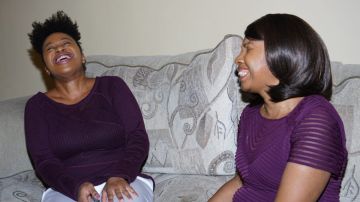3 Garifuna Mothers Share Lessons Learned With Their Daughters
Dai haruga, numada

Photo: Courtesy of Sergio Santos
Dai haruga, numada.
My mom, Juana, would whisper the familiar phrase, which means see you later/until tomorrow, friend, before closing my bedroom door at night. She didn’t speak Garifuna to me regularly, but there were some words and phrases she’d sprinkle into our daily conversations.
While I didn’t always have the vocabulary or knowledge to articulate the history, my mother made sure my brother and I knew we were Black Latinos from Honduras, and more specifically Garifuna. The term describes both a language and group of people that live along the coast of Belize, Guatemala, Honduras and Nicaragua. We were never enslaved and are descendants of West African survivors of human cargo ships that were wrecked off the island of St. Vincent. With origins that blend Arawak, Carib and West and Central African, the Garinagu remained in the area, resisting European control, until they were exiled from the country and left on the Honduran Bay Island of Roatán.

My mother sharing traditional foods like hudutu (machuca), or music and dance such as punta was her way of passing on culture. “I tried to instill in you to learn about the culture,” she shared with me, as we reflected on my upbringing. “Always understand your culture and know your people. You should always go back to see where you came from and the root of your culture.”
In speaking with two Garifuna mothers and change agents, they resonate with my mother’s sentiments. I tapped Dr. Nadia Lopez, author of The Bridge to Brilliance and founding principal of Mott Hall Bridges Academy, and author of bilingual children’s book Bad Hair Does Not Exist! (¡Pelo Malo No Existe!) Sulma Arzu-Brown to discuss motherhood and how they’ve passed on culture and life lessons to their daughters.
“I make sure they are always hearing me tell the story of our history,” says Arzu-Brown, mom to Suleni Tisani and Bella Victoria. “When they pick a culture they have to talk about in school, they must choose Garifuna. It gets them to do their own research.”
The Honduran-born entrepreneur also encourages them to wear the Garifuna colors of yellow, white and black.
Although Lopez, the daughter of immigrants from Guatemala and Honduras, identifies as Garifuna via her father, she’s also Black Carib through her Guatemalan mother and shares that layered history with her teenage daughter, Cenné.
“My daughter is taught to be proud of who you are and understanding you come from a long line of people who are fighters, and won’t accept anything less than what you are entitled to, so we have that fighting spirit,” shares Lopez.
The esteemed educator drives home the point to her daughter that in today’s society to be Black Latina comes with a complex set of stereotypes and prejudice. “Overall as Latina women, especially being dark-skinned, Latina women, we have so much we have to stand against. Parents who come from a background of immigrant families but then on top of that you’re Black and then you’re a Latina…there are so many low expectations, and then there are stereotypes. You constantly have to challenge people to break through those stereotypes.”
It’s those stereotypes that inspired Arzu-Brown to pen Bad Hair Does Not Exist in 2014 after her youngest daughter’s babysitter referred to her hair as “pelo malo.” She used what could’ve been anger and created an empowerment tool for young girls globally. Her daughters are her world and, in her own words, have allowed her to be the woman God calls her to be.
“My daughters are good human beings,” describes Arzu-Brown. “I look up to them. They are fearless when they have to be, they are thoughtful. They love each other in a way they don’t even understand.” Her daughters have also taught her to be more patient and not jump to conclusions, which she learned she was doing from her eldest. After listening, she took her feedback and implemented the change. “I applied it.”
My mother and I realize we’ve learned so much from one another as well. A lesson she’s taught me that is a huge part of my life is to start my day positively. “Always send your children out with a positive attitude in the morning,” she mentioned. It’s as simple as telling them to have a good day. It provides a positive outlook.” Nearly 30 years later, my morning regimen is still something that frames the way the rest of my day goes.
She’s also instilled in me the value of hard work and perseverance, and I find myself pushing toward my goals as I hear her wise words in my head. “If you continue chiseling away at whatever it is that you want, you’ll eventually get it. Nothing is achieved in one day. Keep at it.”
For Lopez, a big lesson that she’s learned from her mother and has passed on is to advocate for herself. With English being her second language, Lopez’s mother still ensured her daughter had the best schooling and opportunities. “I carried that with my daughter. I want you to ask as many questions as possible. If someone fails to acknowledge and honor you then you bring that to my attention and I will fight that fight for you.”
The level of hard work that comes along with mothering can’t be captured, but, as each of these mothers have revealed, it’s the lessons learned that have helped them along the way.
What lessons have you learned from your mother? Share them with us in the comments section, below.
[article_ad]

















